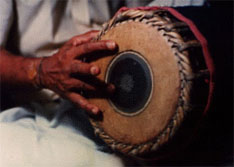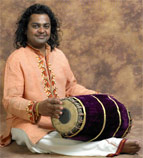MRIDANGAM
The Indian Musical Instrument Mridangam is one of the most popular classical instruments of South India. Mridangam accompanies vocal, instrumental and dance performances. Mridangam is the main instrument that provides rhythm and raga to Carnatic music performances. It is also known by the name of mridanga, mrdangam, mrudangam and mrithangam.
In Hindu mythology, mridanga /mridangam is shown often as the instrument of many popular deities such as Ganesha and Nandi vehicle or companion of Lord Shiva. Accordingly it is believed that Nandi played the mridangam during Shiva's Tandava dance and due to these reasons mridangam is also known as "Deva Vaadyam," (the instrument of the Gods).
Brief Introduction

The goat skin smaller aperture is smeared in the center part with a black round spot that is made of rice flour, starch and ferric oxide. This black paste is known as the "Satham" or "karnai" and which provides the mridangam its distinct metallic timbre. The present day mridangam is made of a single block of wood. It is a barrel-shaped double-headed drum, the right head being smaller than the left. The two heads are made of layers of skin. The mridangam is played with hands, palms and fingers. The mridangam is played from both sides. Mridangam is similar in appearance to the Pakhawaj but the ends have a different texture. It is the most used drum in South Indian music.
Popular Musicians

Jaya Bhaskar took to Mridangam at the age of nine and received his training in Gurukula System from Padma Sri Dr. Yella Venkateswara Rao, who belongs to the Guru-Shishya Parampara of Mridangam Maestro Palgat Mani Iyyer. He was awarded the Government of India Senior Scholarship for Mridangam.
Where to learn to play Mridangam
TARANG School for Classical Indian Dance and MusicManager: Marie-Luise Siebenkaes
Johannisstrasse 14D-90763 Fuerth
Germany Telephone: +49-(0)911-6708040
Fax: +49 (0)1212-512616701 USt-IdNr.: DE228189973
K.V.R. Mridanga Kalakshetram
Category: Instrumental Music Classes, Vocal Music Classes
Address: Somayajulu, Vidya Nagar
Nallakunta
Hyderabad -500044
Where to buy a Mridangam
Contact: Mr Ashish ShrivastavaSathyadeep Musical Palace
Beside Vysya Bank
Post- Puttaparthy
Dist-- Anantapur
Andhra Pradesh Pin- 515134
INDIA
[email protected]
[email protected]


